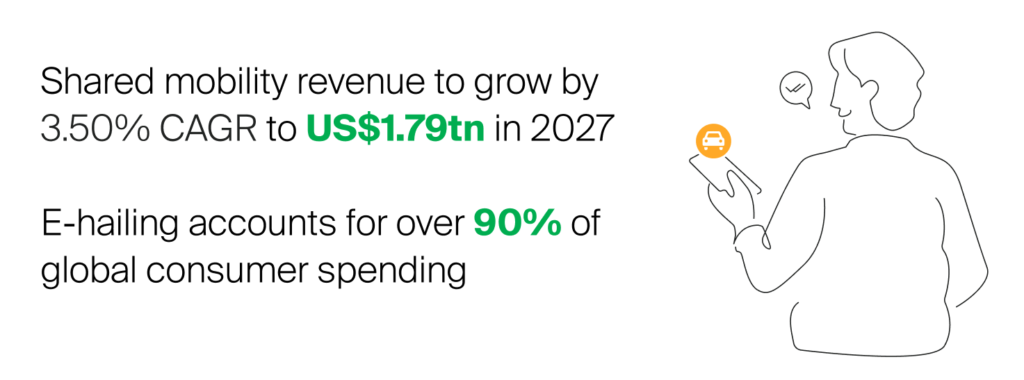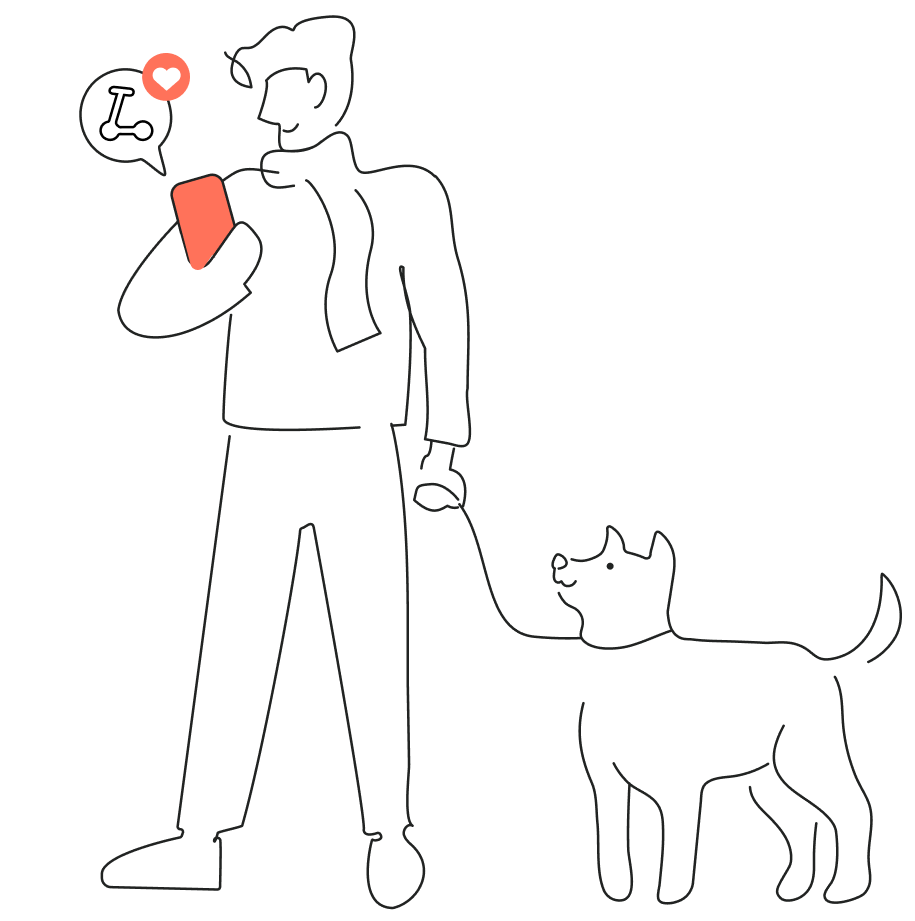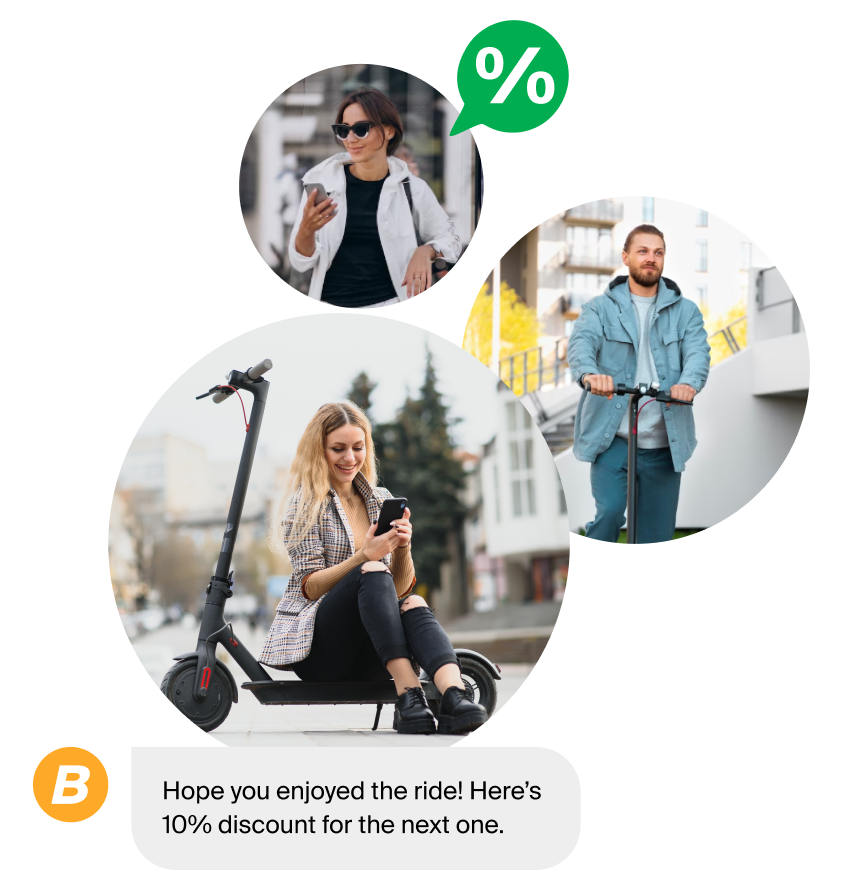Expected to reach a market value of US$1.56tn this year (2023), the shared mobility sector is an exciting space to be in right now. However, whilst consumers believe the environmental benefits are important, there are challenges in the sector that are making segments of society reluctant to make the switch from car ownership. First and foremost, 53.7% want an app and services that are easy to use. Others, such as Millennial parents, don’t feel that shared mobility companies cater for their diverse needs.
The good news is that e-hailing and micro-mobility businesses can utilise technology like SMS to improve sign-ups, and chatbots to educate and support, whilst innovative loyalty schemes encourage good behaviour and boost customer retention.
Shared Mobility Financial Forecasts

If you’re keen to know the potential of your shared mobility business, consider these impressive market forecast statistics. Statista predicts that the shared mobility sector will grow by 3.50% over the next four years to reach a market volume of US$1.79tn in 2027. As expected, e-hailing remains the most popular form of shared mobility, accounting for over 90% of global consumer spending in the sector. This category is expected to reach global revenues of $450-$860bn by 2030. Shared micro-mobility is also on the rise and could account for around 10 percent of the overall market by the same year. According to McKinsey modelling, urban aerial mobility will take off (pun intended) and could total to more than $10 billion by 2030. Looking a little further into the future, robo-taxis and robo-shuttles will likely begin to overtake car-sharing and pooled e-hailing.
Social & Environmental Impact
It’s clear that the individual and global benefits of shared mobility are manifold, including reduced congestion and carbon emissions in line with the goals of the Paris Agreement and the Shared Mobility 2030 Action Agenda. The positive impact would be significant as the transport sector causes approximately 33% of all carbon dioxide emissions in Europe, with 70% of this coming from cars, trucks, vans and buses. This in turn would mean less wear and tear on the roads, enabling local authorities to reimagine public transport and infrastructure budgets to make improvements. It’s also a great money-saver for consumers, which should be welcome in the current economic downturn.
However, these benefits alone are not sufficient for consumers to fully embrace shared mobility, so let’s explore what does drive adoption.
Fast, Efficient & Reliable

The most important features of shared mobility services are safety, a competitive price, and availability. Those consumers who prefer owning their own car cite convenience (70%), freedom (69%) and flexibility (62%) as their top reasons. So, shared mobility vendors who offer a CX that meets all these requirements are likely to be successful, while also improving public perception and encouraging wider adoption. Improving the shared mobility CX and achieving these goals requires addressing some of the sector’s most pressing challenges.
Hit the Brakes on Abandonment
It’s incredibly frustrating for a micro-mobility customer when they can’t use the service because the bicycle or moped is not at the specified pick-up point or because it’s damaged. Abandoned and incorrectly parked micro-mobility vehicles are unsightly and harm the reputation of the industry as a whole.
The Ride of Your Life
Shared mobility businesses can assuage this problem by introducing new user rules, gamification and loyalty incentives for proper parking. For example, you can require users who have completed their journey to take an in-app photo of the vehicle, parked in a proper drop-off point, before they can close the rental and end payment. A timely transactional SMS will remind them to take the right action. A promotional SMS with a link to your loyalty scheme, which rewards proper parking with free ride points (or in-app currency) serves as an incentive to do the right thing. Your chatbot can also promote your reward scheme and provide users with educational FAQs, with the essentials pared down into a digestible 1-minute read with reward points for checking it. Better fleet management results in greater customer acquisition and retention, as well as wider reputation management of the shared mobility industry as a whole.
Another great app feature that aids availability is allowing users to pre-book their journeys, as well as sending them an SMS notification once a vehicle is available in their pre-chosen or current location.
The Road to Recovery
30% of 18 to 24-year-olds rank environmental sustainability as the highest priority incentive for ride sharing, above cost savings at 25%. So, an SMS or chatbot loyalty campaign targeted at the Gen Z eco-warrior market segment is likely to be a winner. After each ride, send them an SMS showing how their shared mobility mileage has made a positive impact on their carbon footprint and rewarding them with sustainability points towards a prize or a free ride.
Step on the Gas with SMS
A critical factor to shared mobility customer acquisition and retention is a fast and efficient sign-up process. If you require a prospect to sign up via an app, make a clumsy channel change to email pdfs of a driver’s permit and then a long wait for verification, they will go elsewhere. Enabling sign up and sign-in via a transactional SMS is great for a simplified CX, better security, and a speedy service. It’s much harder for would-be fraudsters to set up a new phone account than an email, plus SMS provides secure authentication. SMS also scales easily and affordably with your business and can be used internationally without any additional investment.
What’s Driving Consumers Round the Bend?

A recent Ericsson report highlighted an interesting contradiction. 57% of consumers said they expected the shared mobility market to grow substantially from 2021 to 2026, mostly due to the environmental benefits, but only 10% intended to use it themselves. On the surface this seems paradoxical and more than slightly confusing for the leaders of shared mobility businesses. However, if we dig a little deeper into which consumers are reluctant to share, and why, the data reveals some amazing opportunities for providers to succeed in targeting and converting new market segments.
Taking a U-turn
70% of Millennials believe that environmental problems such as climate change and waning biodiversity are serious enough to warrant drastic lifestyle changes. It’s surprising then that 76% of Millennial parents feel it’s essential that they own a car. They believe it’s the only mode of transport that gives them flexibility, speed, efficiency, reliability and the safety features they need to manage the schedules of multiple family members successfully. e-Hailing companies that can help this market segment overcome this emotional and practical dilemma will likely have loyal customers for life. You could decide to differentiate your ride-hailing service and appeal to Millennial parents by having designated kid-friendly cars. This could mean hiring “care-giver” drivers who meet legal requirements for driving children unaccompanied, like popular e-hailing businesses KidCar and Kango. Alternatively, you could allow groups of children to ride-share with a parent chaperone, or simply make normal e-hailing vehicles more kid-friendly by ensuring drivers carry 2 top of the range, great condition car seats in the boot. Similarly, you could provide pet-friendly cars, with blankets, dog treats and canine seat belts, to take dogs to weekly appointments, like to their groomer. Use SMS to notify parents when the car is arriving, what time the child is picked up, and when they arrive safely at their destination, to supplement the in-app tracking.
Embracing the Backseat Driver
For other generational segments, lack of comfort is their reason for preferring car ownership over e-hailing. So, simply instructing drivers to maintain a high standard of vehicle cleanliness and repair and personal hygiene is a start. Ensure all cars are equipped with fresh water, tissues, a sewing kit, and a neck pillow. Get drivers to ask riders for their needs regarding music, conversation or total silence and a preferred route. You could even create a more expensive deluxe ride with in-car television and gaming so that die-hard drivers can see what it really means to relax as a passenger. All these small changes make for a CX that customers will remember and want to enjoy again. Keep customers and prospects updated about your comfort improvements with an SMS campaign with incentives like a discount for a first luxury comfort ride. When customers interact with your chatbot make sure it also promotes these upgrades and offers as part of the customer service conversation.
The Service Station
77% of cross-sector consumers say excellent customer service is essential for customer acquisition and brand loyalty. In a related study, 69% of respondents said they prefer chatbots to contact centres because they respond to their queries instantly. The shared mobility sector is no different from any other in this respect, so a customer services chatbot, which can save you up to 30% in customer support costs, and which can be used for promotions and upselling, is a great way to keep customers happy and boost revenue. Market leaders like Lyft have embraced chatbots to provide the best possible CX. Up and coming shared mobility businesses that want to stand out and make their competitors feel like a third wheel, would be wise to follow suit.

